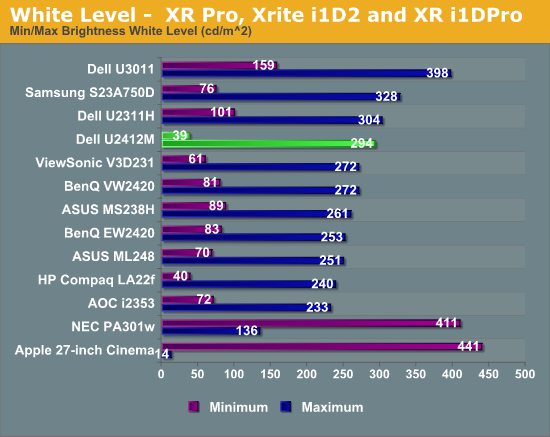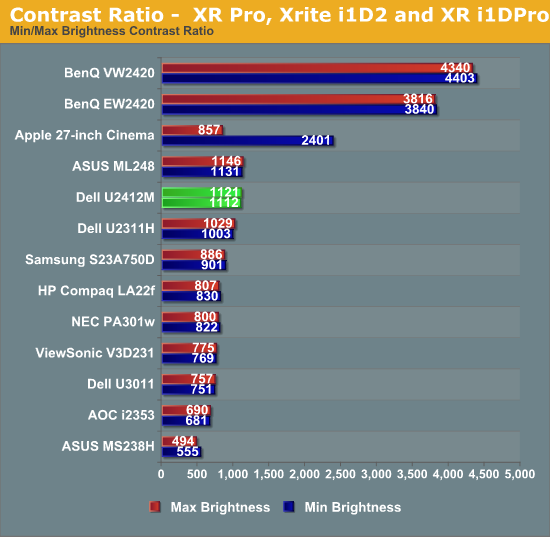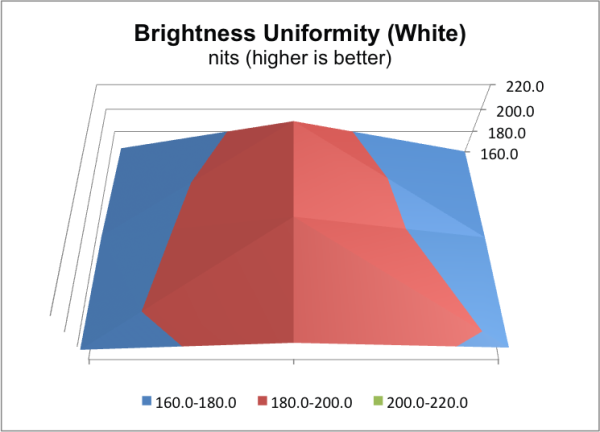Dell U2412M - 16:10 IPS without Breaking the Bank
by Chris Heinonen on February 28, 2012 9:00 AM ESTDell U2412M Brightness and Contrast
Despite the larger size of the display compared to recent 23” monitors I have reviewed, the U2412M says it can produce 300 nits of light at maximum output, which should certainly be bright enough for anyone to use. It’s worth noting that I usually set the display around 5 nits too high before calibration, to allow for a little headroom when ColorEyes generates the curves. However this also means that maximum light output, once calibrated, might be around 5% lower than maximum due to the curves inside the ICC profile.

Despite this possible limitation, the Dell still put out 294 nits at maximum brightness after calibration, and 39 nits at minimum brightness. This was plenty bright for my work area, even with bright overhead lights, and the combination of the high brightness and anti-glare coating made it easy to see the screen.
The weak area for IPS screens has always been the black levels, with them being much higher than those from VA based displays. The U2412M did well here, out performing all recent non-VA displays with a nice, low black level.

With this combination of black level and a very bright screen, we would expect to see a decent contrast ratio to come out as well, and the Dell delivers here.

Beating the specified number by over 10% is always nice to see, and the contrast on the Dell is very nice. It easily outperforms most TN displays, though it's not able to compete with the combination of LED lighting and a VA panel from BenQ. It was also very stable across the spectrum, with virtually identical ratios at maximum and minimum brightness.
While the center stayed nice and bright, the edges showed a good amount of fall off in comparison, and an overall variance of around 6%. The areas with higher brightness uniformity issues were also the areas with higher dE values on the uniformity testing, just as we expected. Looking at black uniformity, thanks to the bright corners this wound up even worse, with a variance of around 14%.
Taken as a whole, the contrast ratios are good, and while there is light fall-off at the edges of the display, it does not seem to have a noticeable effect on color quality.












143 Comments
View All Comments
ExarKun333 - Tuesday, February 28, 2012 - link
Dio you need to be spoon-fed? Dell makes more expensive IPS monitors. You just need to go to Dell.com to see them. U2410, U2711, U3011, etc.DParadoxx - Tuesday, February 28, 2012 - link
I dont because I already own those monitors. The point is to give feedback for the site. Thanks!cheinonen - Tuesday, February 28, 2012 - link
Perhaps a comment like "What I'd like to see in the future are some reviews of 16:10 panels with true 8-bit or 10-bit IPS panels" would be more helpful, since when it just says "Finally a 16:10 review, but its eIPS.... no thanks." I have no idea if you want TN, 10-bit IPS, VA, 120 Hz, etc...kevith - Wednesday, February 29, 2012 - link
Behold, a fair and enlightened rich kid, nice.Touche - Tuesday, February 28, 2012 - link
What are the disadvantages of eIPS?phantom505 - Tuesday, February 28, 2012 - link
6 bit with tricks vs true 8 bit.... read 1st page.Oxford Guy - Tuesday, February 28, 2012 - link
Also, e-IPS has narrower viewing angle than S-IPS/H-IPS.Ratman6161 - Tuesday, February 28, 2012 - link
My older U2410's are also 1920x1200. We also have a slew of Cheap Dell 19 inchers that are 1440x900 which, unless my math is flawed is also 16:10. Paging through their consumer oriented models you do mostly see 16:9. But if you check out the small business section (or corporate or Education\Government) you can find lots of 16:10 options.Death666Angel - Tuesday, February 28, 2012 - link
Did you read the first page? He never said this was new. He said it was where wide screen started and then faded away concerning the budget displays.Considering the price of this monitor, it is a rather new thing to find 16:10 with non-TN panel insides.
Ratman6161 - Tuesday, February 28, 2012 - link
What I'm saying is that 16:10 budget displays never did fade away. You just have to know where to look for them and it will not be with the consumer oriented products. At my office we have at least 60 19 inch 16:10 displays. We got about half of those in mid 2009 and the rest in mid 2011 for about $139 each.